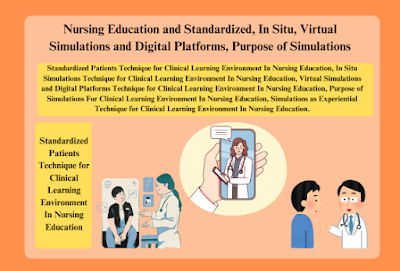The Standardized In Situ Virtual Simulations and Digital Platforms Purpose of Simulations In Nursing Education. Healthcare simulation is the modern method of educating and training healthcare professionals to learn cognitive, technical, and behavioral skills through technologically advanced, purpose-built experiences.
The Standardized In Situ Virtual Simulations and Digital Platforms Purpose of Simulations In Nursing Education
Simulation plays a crucial role in nursing education, providing students with a safe environment to practice and refine their clinical skills. There is considerable evidence that simulation effectively bridges the gap between traditional classroom learning and clinical practice.
In healthcare professions, virtual reality simulation uses computers and standardized patients to create a realistic learning and assessment environment. Virtual simulation utilizes practice-specific clinical scenarios: a highly adaptable, repetitive, and structured activity with explicit learning objectives. The goal is to improve students’ performance in clinical decision-making skills for identifying patient problems and in decision-oriented care management.
By implementing simulations, students can practice their clinical and decision-making skills on important problems they may encounter in their daily work. The protected environment and sense of security strengthen students’ self-esteem and self-confidence, thus promoting learning.
Purpose of Simulations In Nursing Education
1. Definition:
- Standardized patients are trained actors who simulate real patient scenarios based on scripts provided by faculty. They display clinical symptoms and respond as actual patients would.
2. Uses:
- Assessment Skills: Evaluating physical assessment skills, history taking, and communication techniques.
- Objective Structured Clinical Examination (OSCE): This includes evaluating psychomotor skills and patient teaching through standardized scenarios.
3. Benefits:
- Provides a controlled, realistic environment for students to practice and be assessed on their clinical and communication skills.
In Situ Simulations Technique
1. Definition:
- In situ simulation involves conducting training in real clinical settings where patient care occurs. This method aims to provide high realism by integrating learning into the actual clinical environment.
2. Uses:
- Real-Life Application: Helps bridge the gap between theoretical knowledge and real-life application by practicing in the actual care setting.
- Interdisciplinary Training: Often used with professional teams to enhance teamwork and problem-solving in real-world contexts.
3. Benefits:
- Realistic Experience: Students experience and adapt to the dynamics of a real clinical environment.
- Immediate Application: Facilitates adult learning by allowing immediate application of knowledge in relevant situations.
Virtual Simulations and Digital Platforms
1. Definition:
- Virtual simulations occur in digital environments where learners interact with virtual patients and settings. Platforms like Second Life offer immersive experiences through avatars and virtual interactions.
2. Uses:
- Simulation Platforms: Tools like Second Life simulate clinical practice scenarios and inter-professional interactions.
- Game-Based Learning: Provides opportunities for independent or moderated practice with real-time responses and feedback.
3. Benefits:
- Flexibility: Allows learners to engage in simulations at their own pace and from various locations.
- Access to Scenarios: Facilitates the practice of scenarios that may be rare or complex, offering a safe environment to learn and make decisions.
4. Examples:
- Second Life: Used for inter-professional education and virtual clinical scenarios, though technical challenges may arise.
Purpose of Simulations in Nursing Education
1. Teaching Strategy:
- Simulations provide a hands-on learning experience where students can practice and refine their skills in a risk-free environment.
2. Assessment and Evaluation:
- Used to evaluate students’ clinical competencies, decision-making abilities, and ability to apply theoretical knowledge in practical scenarios.
3. Encouragement of Inter-professional Education (IPE):
- Simulations foster collaboration and understanding among different healthcare professions, improving teamwork and patient care quality.
Simulations as Experiential Learning
1. Experiential Learning Cycle:
- Concrete Experience: Engaging in simulations.
- Reflective Observation: Reflecting on the experience.
- Abstract Conceptualization: Deriving meaning from the experience.
- Active Experimentation: Applying learned concepts in new situations.
2. Benefits:
- Application of Theory: Allows students to apply theoretical knowledge in practical settings.
- Skill Development: Enhances both basic and advanced clinical skills in a controlled, supportive environment.
- Confidence Building: Provides practice opportunities to build confidence before interacting with real patients.
3. Use of High-Fidelity Simulations:
- Complex Scenarios: Enables practice of complex clinical scenarios, such as emergency responses and leadership skills.
- Safe Learning: Allows for repeated practice and skill refinement without risk to actual patients.
4. Advanced Practice:
- High-fidelity simulations support the development of leadership, teamwork, and decision-making skills in advanced nursing practice.
Read More:
https://nurseseducator.com/didactic-and-dialectic-teaching-rationale-for-team-based-learning/
https://nurseseducator.com/high-fidelity-simulation-use-in-nursing-education/
First NCLEX Exam Center In Pakistan From Lahore (Mall of Lahore) to the Global Nursing
Categories of Journals: W, X, Y and Z Category Journal In Nursing Education
AI in Healthcare Content Creation: A Double-Edged Sword and Scary
Social Links:
https://www.facebook.com/nurseseducator/
https://www.instagram.com/nurseseducator/
https://www.pinterest.com/NursesEducator/
https://www.linkedin.com/in/nurseseducator/
https://www.researchgate.net/profile/Afza-Lal-Din
https://scholar.google.com/citations?hl=en&user=F0XY9vQAAAAJ

You actually said that very well.
casino en ligne fiable
Truly quite a lot of useful data!
casino en ligne
You actually mentioned that very well.
casino en ligne
Incredible a good deal of very good data.
casino en ligne
You revealed that fantastically!
casino en ligne fiable
Thanks a lot! Wonderful information!
casino en ligne France
Nicely expressed indeed. .
casino en ligne
Helpful forum posts, Kudos.
casino en ligne
You actually stated this perfectly!
casino en ligne francais
Wow quite a lot of beneficial knowledge!
meilleur casino en ligne